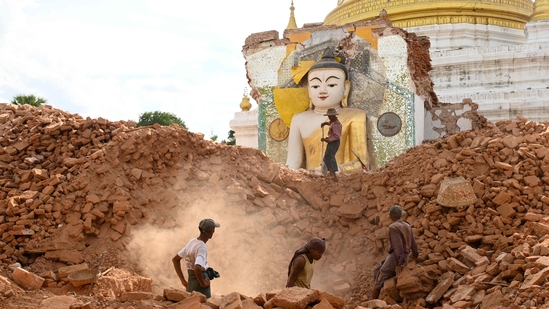13 April 2025 (Punjab Khabarnama Bureau): Four earthquakes struck parts of India, Myanmar, and Tajikistan within just one hour on Sunday morning, raising concerns across central and South Asia. From Himalayan towns to Central Asian cities, the tremors caused residents to flee buildings in fear, reminding many of the region’s volatile tectonic landscape.
Mandi earthquake
The first quake hit at 9 am in Mandi district of Himachal Pradesh, where a magnitude 3.4 tremor was recorded at a shallow depth of 5 km, according to the National Center for Seismology (NCS). The epicenter was located at 31.49°N, 76.94°E.
Though considered minor, the quake was strong enough to be felt by residents, many of whom reported hearing a low rumble followed by a sudden shake. Startled locals rushed out of homes and offices into the open, according to local media reports.
No injuries or property damage have been reported so far.
Myanmar: New tremor amid ongoing tragedy
Soon after, a 5.5-magnitude earthquake struck near Meiktila in central Myanmar, according to the US Geological Survey (USGS). The tremor was one of the strongest aftershocks since the catastrophic 7.7 magnitude earthquake on March 28, which killed over 3,600 people and left thousands injured.
This latest quake was felt in both Mandalay and Naypyitaw, cities still reeling from the March disaster.
Two Wundwin residents told The Associated Press by phone the quake was so strong that people rushed out of buildings and that ceilings in some dwellings were damaged. A resident of Naypyitaw also reached by phone said he did not feel the latest quake. Those contacted asked not to be named for fear of angering the military government, which prefers to closely control information.
No new casualties have been reported, but the tremor has intensified anxiety in a country already dealing with grief and loss.
Twin tremors in Tajikistan
At 9.54 am, a 6.1 magnitude earthquake struck Tajikistan, originally estimated at 6.4. The quake hit at a depth of 10 km, with its epicenter at 38.86°N, 70.61°E, making it the strongest quake of the morning.
People in nearby towns reported feeling significant shaking, with some shops and schools evacuated as a precaution.
Then, at 10.36 am, another 3.9 magnitude tremor hit the region, again at a depth of 10 km, deepening concerns about increased seismic activity in the area.
How earthquakes are measured
Earthquakes are measured using a seismograph, which records the energy released during a seismic event. The magnitude indicates the size or strength of an earthquake and is commonly measured on the Richter scale or the more modern Moment Magnitude Scale (Mw).
Magnitude 3-4: Often felt, rarely causes damage
Magnitude 5-6: Moderate to strong, can cause damage to poorly built structures
Magnitude 6+: Strong to major earthquakes, potentially causing widespread destruction
The depth of the earthquake – how far below the Earth’s surface the quake originates – also plays a crucial role. Shallower quakes, like those felt today, tend to be more strongly felt on the surface, even if the magnitude isn’t very high.
Summary: Four earthquakes rattled India, Myanmar, and Tajikistan within an hour, sparking fresh fears in seismically active regions.

